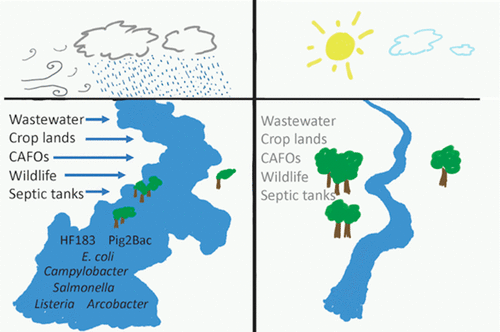当前位置:
X-MOL 学术
›
ACS ES&T Water
›
论文详情
Our official English website, www.x-mol.net, welcomes your
feedback! (Note: you will need to create a separate account there.)
Microbial Contamination in Environmental Waters of Rural and Agriculturally-Dominated Landscapes Following Hurricane Florence
ACS ES&T Water ( IF 4.8 ) Pub Date : 2021-08-23 , DOI: 10.1021/acsestwater.1c00103 Angela R. Harris 1 , Emine N. Fidan 2 , Natalie G. Nelson 2 , Ryan E. Emanuel 3 , Theo Jass 3 , Sophia Kathariou 4 , Jeffrey Niedermeyer 4 , Mahmoud Sharara 2 , Francis Lajara de los Reyes 1 , Diego A. Riveros-Iregui 5 , Jill R. Stewart 6
ACS ES&T Water ( IF 4.8 ) Pub Date : 2021-08-23 , DOI: 10.1021/acsestwater.1c00103 Angela R. Harris 1 , Emine N. Fidan 2 , Natalie G. Nelson 2 , Ryan E. Emanuel 3 , Theo Jass 3 , Sophia Kathariou 4 , Jeffrey Niedermeyer 4 , Mahmoud Sharara 2 , Francis Lajara de los Reyes 1 , Diego A. Riveros-Iregui 5 , Jill R. Stewart 6
Affiliation

|
Hurricane Florence brought unprecedented rainfall and flooding to Eastern North Carolina in 2018. Extensive flooding had the potential to mobilize microbial contaminants from a variety of sources. Our study evaluated microbial contaminants in surface waters at 40 sites across Eastern North Carolina 1 week after the hurricane made landfall (Phase 1) and one month later (Phase 2). High concentrations of Escherichia coli were detected in flowing channel and floodwater samples across both phases; however, channel samples during Phase 2 had higher concentrations of E. coli compared to Phase 1. Human- and swine-associated fecal markers were detected in 26% and 9% of samples, respectively, with no trends related to phase of sampling. Arcobacter butzleri was previously shown to be recovered from most (73%) samples, and detection of this pathogen was not associated with any source-associated fecal marker. Detection of Listeria spp. was associated with the swine-associated fecal marker. These results suggest that improved swine and human feces management should be explored to prevent microbial contamination in surface water, especially in regions where extreme rainfall may increase due to climate change. Sampling at higher frequency surrounding rainfall events would provide more detailed characterization of the risks posed by floodwater at different time scales and under different antecedent conditions.
中文翻译:

佛罗伦萨飓风过后农村和以农业为主的景观环境水域中的微生物污染
2018 年,佛罗伦萨飓风给北卡罗来纳州东部带来了前所未有的降雨和洪水。大范围的洪水有可能从各种来源调动微生物污染物。我们的研究在飓风登陆后 1 周(第一阶段)和一个月后(第二阶段)评估了北卡罗来纳州东部 40 个地点地表水中的微生物污染物。在两个阶段的流道和洪水样本中均检测到高浓度的大肠杆菌;然而,与第 1 阶段相比,第 2 阶段的通道样本具有更高浓度的大肠杆菌。分别在 26% 和 9% 的样本中检测到人类和猪相关的粪便标记物,没有与采样阶段相关的趋势。布氏弧杆菌以前显示可从大多数 (73%) 样本中回收,并且检测到这种病原体与任何来源相关的粪便标记物无关。检测李斯特菌。与猪相关粪便标记物有关。这些结果表明,应该探索改进猪和人类粪便管理,以防止地表水中的微生物污染,特别是在由于气候变化而极端降雨可能增加的地区。在更高频率的降雨事件周围进行采样,可以更详细地描述不同时间尺度和不同先行条件下洪水造成的风险。
更新日期:2021-09-10
中文翻译:

佛罗伦萨飓风过后农村和以农业为主的景观环境水域中的微生物污染
2018 年,佛罗伦萨飓风给北卡罗来纳州东部带来了前所未有的降雨和洪水。大范围的洪水有可能从各种来源调动微生物污染物。我们的研究在飓风登陆后 1 周(第一阶段)和一个月后(第二阶段)评估了北卡罗来纳州东部 40 个地点地表水中的微生物污染物。在两个阶段的流道和洪水样本中均检测到高浓度的大肠杆菌;然而,与第 1 阶段相比,第 2 阶段的通道样本具有更高浓度的大肠杆菌。分别在 26% 和 9% 的样本中检测到人类和猪相关的粪便标记物,没有与采样阶段相关的趋势。布氏弧杆菌以前显示可从大多数 (73%) 样本中回收,并且检测到这种病原体与任何来源相关的粪便标记物无关。检测李斯特菌。与猪相关粪便标记物有关。这些结果表明,应该探索改进猪和人类粪便管理,以防止地表水中的微生物污染,特别是在由于气候变化而极端降雨可能增加的地区。在更高频率的降雨事件周围进行采样,可以更详细地描述不同时间尺度和不同先行条件下洪水造成的风险。











































 京公网安备 11010802027423号
京公网安备 11010802027423号